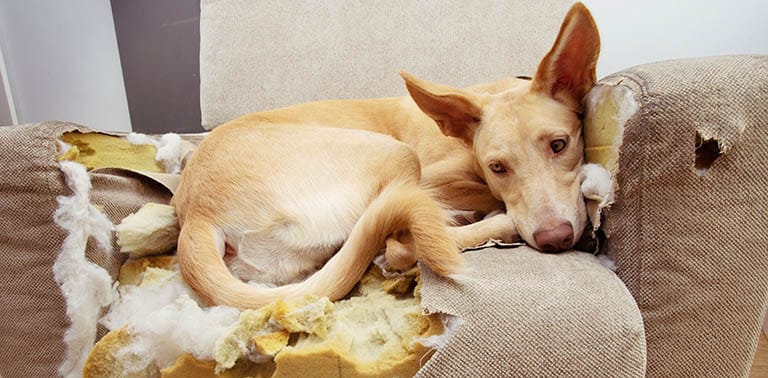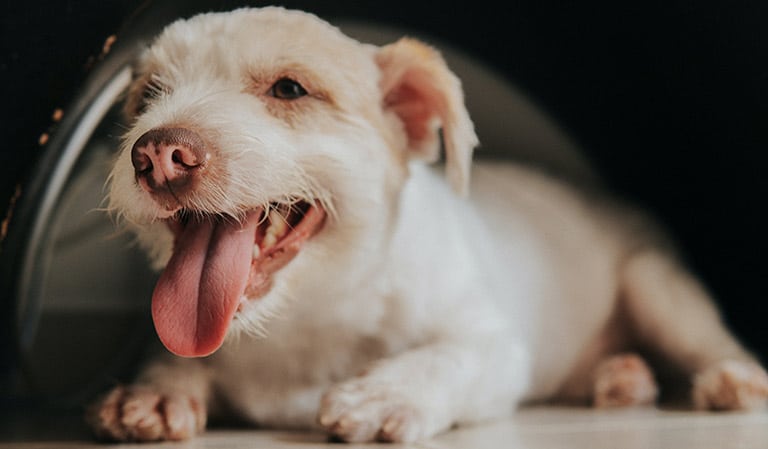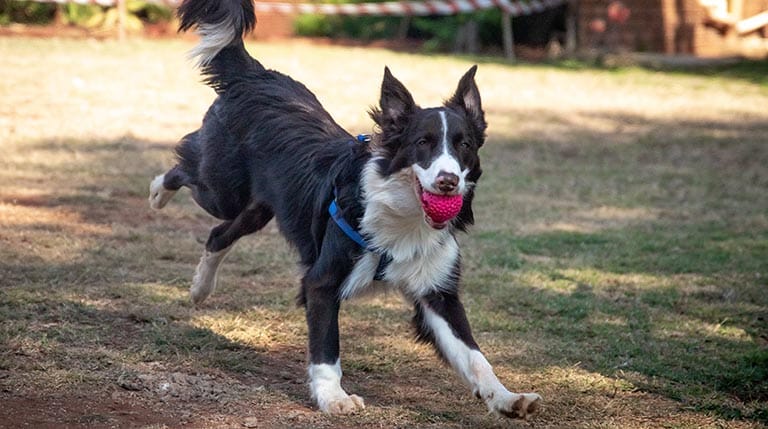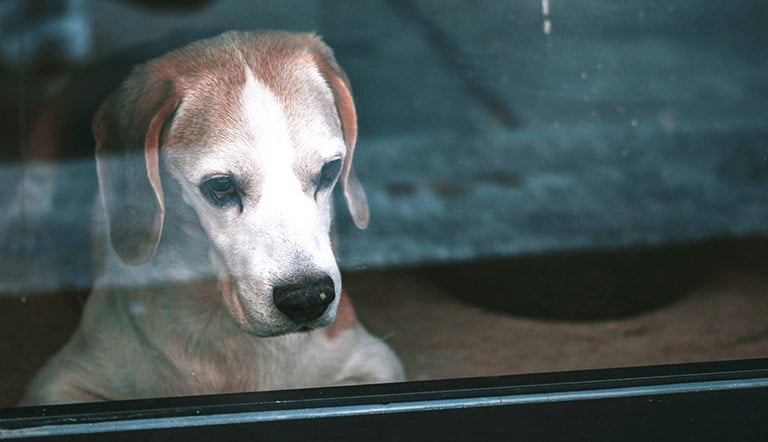Separation anxiety in dogs is a distressing condition that plagues canines when they find themselves left alone. While experts cannot pinpoint the exact causes, certain situations and life transitions can intensify this anxiety. Recognizing the signs is important for a proactive approach, as dogs may exhibit behaviors like pacing, destructive acts, excessive barking and even escape attempts.
This blog delves into the symptoms of separation anxiety in dogs and explores effective strategies like desensitization, counterconditioning, increased exercise, crate training and medications. Help your canine friend cope with your absence in a healthier and safer way.
Why do Dogs Develop Separation Anxiety?
For dogs, separation anxiety is a genuine source of stress triggered when their owner is out of sight or away from home. While the exact causes are not fully understood, some dogs are inherently more prone to experiencing this distress disorder than others.
Certain situations can intensify or contribute to the development of separation anxiety in dogs. For instance, major life transitions such as moving homes or being adopted after a stint in a shelter may heighten these feelings. Changes in routine which result in leaving the pet alone more frequently, like a family member returning to work or school, for example, can also play a role. Moreover, traumatic events such as being abandoned at a shelter, enduring solitude in a boarding kennel or facing abuse and neglect can greatly contribute to the development of separation anxiety in dogs.
Signs Your Dog Has Separation Anxiety
Pacing, Whining and Trembling
As a dog owner prepares to leave, their canine may pick up the subtle cues that they will soon be left alone. The mere sight of their human grabbing the keys, putting on a jacket or slipping on shoes can cause a dog to experience pre-departure anxiety. Anticipating the alone time, the dog may walk around in circles, pace back and forth, whine or tremble. These symptoms commonly continue for the duration of the time the owner is gone.
Barking or Howling
A canine with separation anxiety may loudly bark or howl for an extended period of time when they find themselves alone. These vocal outbursts are a primal expression of how dogs communicate long-distance. When the leader of the pack, or dog owner, is out of sight, the canine attempts to reconnect through barking or howling hoping to hear a response.

Destructive Acts
Destructive behavior is the result of a dog’s intense emotional turmoil at being left alone. One particularly common outlet for their distress is directed at doors: gateways that stand as physical barriers between them and their beloved owner. Their frustration is shown through their biting and clawing as an attempt to get past the separating door.
Other destructive acts include gnawing on furniture, digging or scratching at windows or walls. These actions are releases of nervous energy, attempts to escape or ways to comfort themselves.

Potty Accidents
Indoor accidents are a sign of distress. When experiencing intense separation anxiety, the emotional upheaval becomes so overwhelming a dog may lose control of their bodily functions. Even a dog expertly trained under normal circumstances can succumb to the involuntary release of waste when confronted with the profound anxiety triggered by solitude.
Escape Attempts
Escaping for a dog is a desperate attempt at reuniting with their owner. Driven by the need for connection, the devoted canine may resort to extreme measures, risking self-harm in the process. Dogs may contort themselves to squeeze through open areas or employ biting and clawing to breach doors. They may even try to break through windows.
Salivating, Drooling and Panting
When left alone, dogs experiencing separation anxiety enter a state of heightened distress. Physiological reactions like salivating, drooling and panting may result as indicators of both exhaustion and fear. The involuntary release of saliva and the increased panting can be the first expressions of their emotional turmoil or be the aftereffects of other signs such as constant pacing or destructive chewing.

Ensure that it’s Separation Anxiety
Boredom and insufficient training can lead to behavioral problems that exhibit similar traits as separation anxiety. To tell the difference, it may be a good idea to purchase a pet camera with audio to observe your dog when they are alone. Separation anxiety symptoms appear immediately or within the first five minutes of the owner leaving. The signs are also much more intense than when they are a result of boredom or insufficient training.
How to Help Your Dog Cope with Their Separation Anxiety
Desensitization and counterconditioning
Desensitization and counterconditioning are effective behavior modification techniques for addressing pet separation anxiety. Desensitization involves gradual exposure to fear-inducing stimuli, while counterconditioning pairs negative emotional triggers with positive experiences. It’s crucial to proceed at the dog’s own pace and avoid triggering fear during training. Seek guidance from a dog training professional or board-certified veterinary behaviorist for the best results.
For dogs with pre-departure anxiety, start by teaching the pet that gathering items or possessions doesn’t always signal that someone is leaving. Gradually increase alone time, beginning with short durations and using rewards like food-filled toys for positive association. Maintain a calm environment, exercise patience and understand that achieving comfort with solitude may take weeks. Consistent, gentle training helps your dog become more at ease when left alone.
For more in depth information on this type of training read here.
Exercise
Exercise is a great way to get a canine’s nervous energy out. Devoting consistent, quality time to your dog through playing and walking can help them with their overall well-being and enter a better place mentally for alone time. Elevate your dog’s exercise routine by extending the duration or diversifying activities. Engage their body and mind by playing fetch, creating a scavenger hunt or simply changing the direction of the normal daily walk.

Crate Training
A crate can serve as a haven for your dog, but effectively introducing it requires a thoughtful approach. Start by selecting a suitable crate with enough space for easy movement, and incorporate soft bedding and items with your scent for comfort. Opt for a secure steel crate, providing both ventilation and limited visibility to reduce stress triggers.
Introduce the crate gradually, allowing the dog to explore freely before progressing to a short period with the door ajar. Build up to longer durations, eventually closing the door. To make crate time enjoyable, offer mentally stimulating toys like a Kong filled with peanut butter.
Crating may not suit every dog, however. Respecting their individual needs and pace is paramount. Understanding and implementing these crate training steps can create a positive association, transforming the crate into a reassuring space for your furry companion.
Medication and Holistic Supplements
For separation anxiety in dogs, over-the-counter medications may provide relief. If this is something you’re interested in exploring, consult with your veterinarian for guidance on the right type, dosage and education on the potential side effects.
Consider natural options like CBD oil, available in pure oil or treat forms. CBD is known for its calming properties. However, always prioritize a veterinarian’s input to ensure the well-being and safety of your furry friend. Read this blog for more info on CBD.

Conquering Your Dog’s Separation Anxiety
Addressing a dog’s separation anxiety requires patience, understanding and a well-thought-out approach. By identifying the signs, dog owners can employ various strategies to alleviate their canine’s distress. From gradual desensitization and counterconditioning to incorporating exercise and crate training, each method plays a crucial role in helping dogs build a positive association with solitude.
Consulting with dog-training professionals and considering medications or holistic supplements under veterinary guidance can also contribute to a dog conquering their disorder. In the journey to ease separation anxiety, a compassionate and committed approach does not only benefit the dog’s well-being but also strengthens the bond between the dog and their owner.



